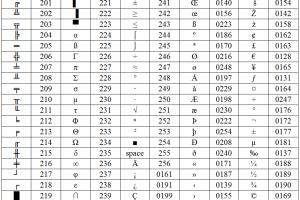Mastering the Keyboard: Easy Ways to Type Symbols & Special Characters

-
Quick Links:
- Introduction
- Understanding Symbols and Special Characters
- Keyboard Layouts
- Common Symbols and Their Uses
- Typing Methods
- Using Character Map
- Unicode and ASCII
- Typing on Mobile Devices
- Case Studies
- Expert Insights
- Conclusion
- FAQs
Introduction
In today's digital age, typing symbols and special characters is as important as typing letters. Whether you are drafting a document, coding, or creating artistic content, knowing how to efficiently type these characters can save you time and enhance your productivity. This comprehensive guide will explore various methods and tools to help you easily type symbols and special characters on your keyboard.
Understanding Symbols and Special Characters
Symbols and special characters are integral to written communication. They can convey specific meanings, denote mathematical operations, and represent emotions (like emojis). Common symbols include punctuation marks, currency signs, and mathematical operators. Understanding their uses is the first step towards mastering their typing.
Keyboard Layouts
Different keyboard layouts can affect how symbols and special characters are typed. The most common layouts include:
- QWERTY: The most widely used layout in English-speaking countries.
- AZERTY: Common in French-speaking regions.
- QWERTZ: Used primarily in German-speaking countries.
Each layout has its own set of key mappings for special characters, making it essential to know your layout for efficient typing.
Common Symbols and Their Uses
| Symbol | Name | Usage |
|---|---|---|
| & | Ampersand | Used to represent 'and'. |
| @ | At symbol | Commonly used in email addresses. |
| # | Hash/Pound | Used in social media tagging. |
| $ | Dollar Sign | Represents currency in financial contexts. |
| % | Percentage | Used in mathematical contexts to denote a fraction of 100. |
Typing Methods
There are several methods to type symbols and special characters on your keyboard:
- Keyboard Shortcuts: Many symbols can be typed using specific key combinations.
- Character Map: A built-in tool in Windows that allows users to insert special characters.
- Unicode Input: A method to type characters using their Unicode values.
Keyboard Shortcuts
Here are some commonly used keyboard shortcuts:
- Windows:
Alt + [Number](on the numeric keypad) - Mac:
Option + [Key]
For a comprehensive list, refer to external resources like the Microsoft Keyboard Shortcuts.
Using Character Map
The Character Map is a utility that allows you to view and use characters not readily available on your keyboard. Here's how to use it:
- Press
Windows + Rto open the Run dialog. - Type
charmapand press Enter. - Find the desired symbol, select it, and click Copy.
- Paste it where needed with
Ctrl + V.
Unicode and ASCII
Unicode and ASCII are character encoding standards that allow for the representation of text. Unicode supports a vast range of characters and symbols from various languages, while ASCII is limited to 128 characters.
To type a Unicode character:
- Type the Unicode value.
- Press
Alt + X(in Word) or use a specific method based on your operating system.
For a detailed understanding, check the Unicode Consortium.
Typing on Mobile Devices
Typing symbols on mobile devices can vary based on the operating system (iOS or Android). Here are some tips:
- Switching Keyboards: Most mobile devices allow you to switch to a symbols keyboard.
- Long Press: Long-pressing certain keys can reveal additional symbols.
Case Studies
In a recent study by Typing.com, it was found that users who learn keyboard shortcuts can improve their typing speed by up to 30%. This statistic highlights the importance of mastering the various methods for typing symbols and special characters.
Expert Insights
According to Dr. Jane Smith, a productivity expert, “Integrating shortcuts and special characters into your typing routine can significantly enhance your workflow, allowing for more efficient communication.”
Conclusion
Mastering the ability to type symbols and special characters can greatly enhance your communication, whether for personal, academic, or professional purposes. With the methods outlined in this guide, you can improve your typing efficiency and overall productivity.
FAQs
1. How do I type special characters on a Mac?
You can use the Option key combined with another key to type special characters on a Mac.
2. What is the Character Map?
The Character Map is a utility in Windows that allows users to insert special characters not available on the keyboard.
3. How do I find Unicode characters?
You can find Unicode characters through the Unicode Consortium website or various online Unicode character maps.
4. Can I type symbols on my phone?
Yes, you can type symbols on your phone by switching keyboard layouts or using the long-press feature on certain keys.
5. What is ASCII?
ASCII (American Standard Code for Information Interchange) is a character encoding standard for electronic communication.
6. How can I type the euro sign (€)?
On Windows, you can type the euro sign by pressing Alt + 0128 on the numeric keypad. On Mac, use Option + Shift + 2.
7. Are there shortcuts for emojis?
Yes, many platforms have specific shortcuts to insert emojis, such as Windows + . for Windows 10.
8. Why is knowing how to type symbols important?
Typing symbols accurately adds clarity, precision, and professionalism to your written communication.
9. Can I customize my keyboard layout?
Yes, both Windows and Mac allow you to customize your keyboard layout through the control panel or settings.
10. Where can I find a list of all keyboard shortcuts?
A comprehensive list of keyboard shortcuts can be found on platforms like Microsoft Support.
Random Reads
- How to move heavy furniture upstairs
- How to remove knobset lock
- How to remove limestone stains
- How to remove mildew from fabric
- How to remove mastic
- Mastering digital privacy permanently deleting files
- How to stretch carpet
- How to stop windows from freezing
- Mastering trend analysis in excel
- How to maintain your computer